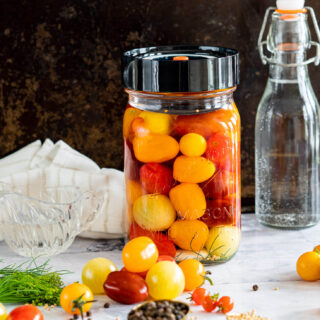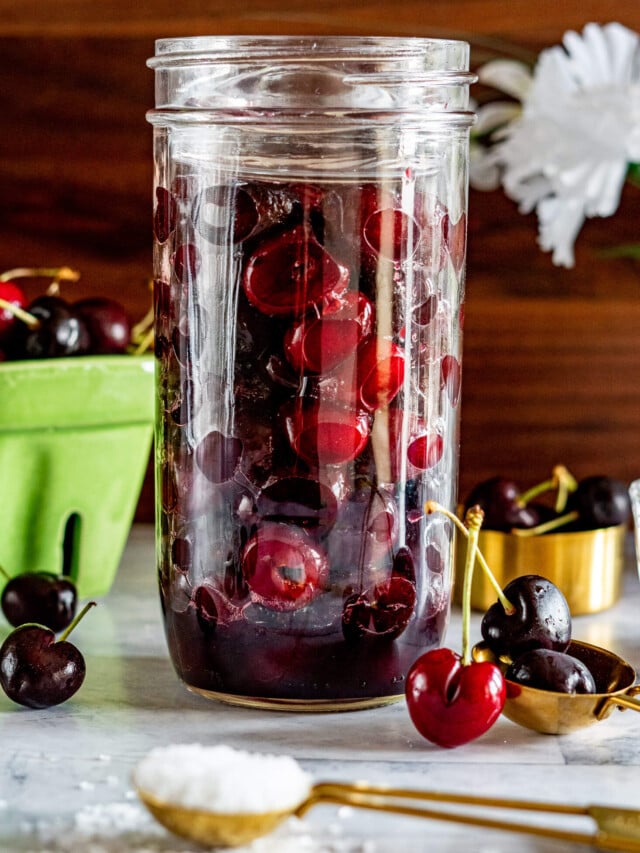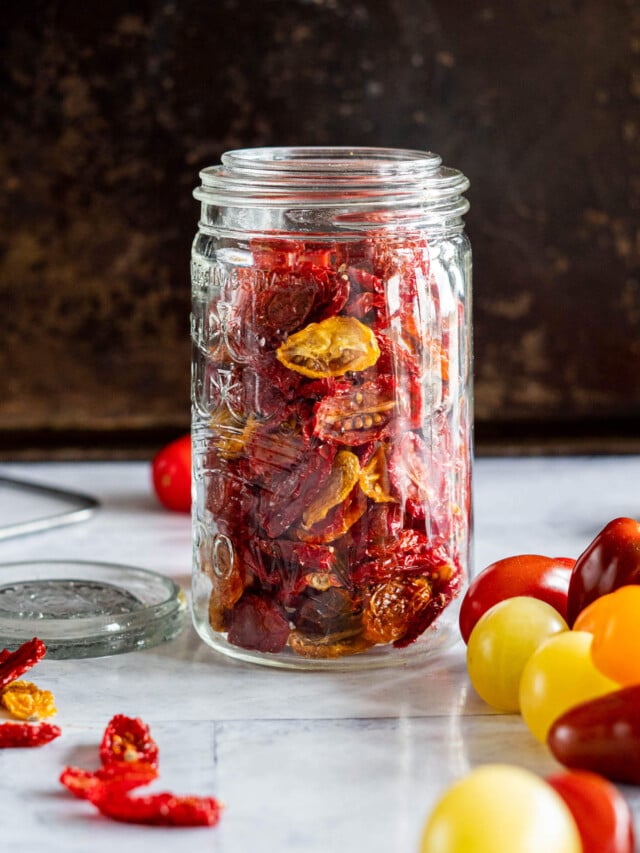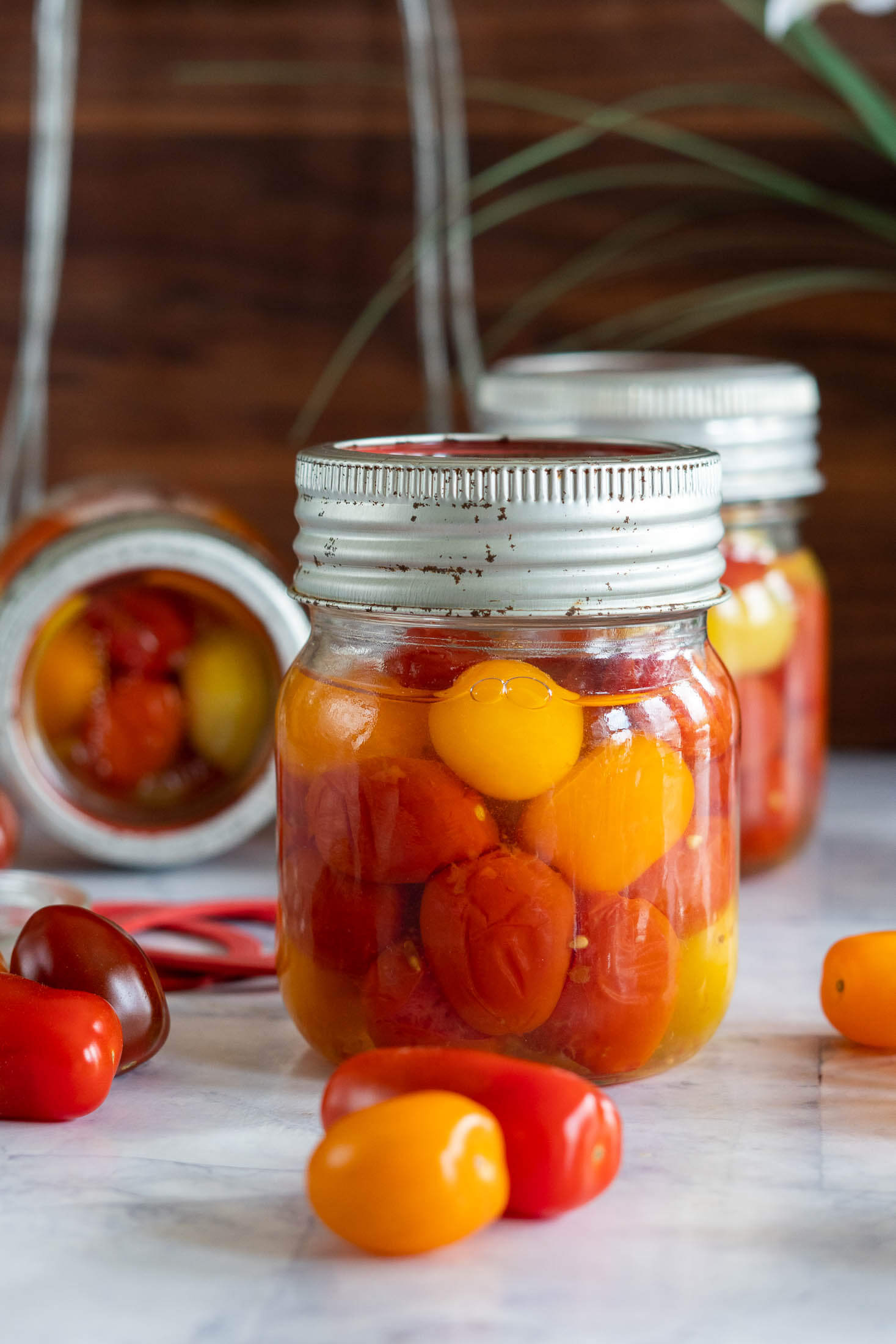Fermented Cherry Tomatoes
As an Amazon Associate I earn from qualifying purchases.
Unleash the full potential of cherry tomatoes with the magic of lacto-fermentation! This easy fermented cherry tomato recipe will have you coming back for more.
I’ll never forget the first time I had a fermented cherry tomato.
Kevin and I were at a charcuterie place for lunch with friends and the huge share board was adorned with little cherry tomatoes.
I popped one in my mouth not thinking anything of it, but I was greeted with an absolute flavor bomb. I could literally feel my eyes widen and my mind racing – trying to understand what was happening in my mouth.
I have spend the last year trying to replicate that feeling. I think I’ve finally nailed it.
This fermented cherry tomato recipe is dedicated to that feeling.

Jump to:
Key Ingredients
Cherry Tomatoes: Use any type of cherry tomato for this recipe, they all work. I’ve used a mix of sun gold, chocolate cherry, sweet 100s and everything in between! For best results, use tomatoes that are ripe but still slightly firm.
If they’re too ripe, they’ll be too soft and won’t hold up well during the fermentation process. On the other hand, if they’re not ripe enough, they won’t have the same rich tomato flavor.
Salt: Choose mineral sea salt for the best flavor profile or coarse kosher salt for the most neutral salt flavor.
Water: Spring water or well water works great in fermenting recipes. Avoid chlorinated water wherever possible as chlorine can affect microbial activity. I use straight well water or well water run through my RO system for all my ferments.

How To Ferment Cherry Tomatoes
Prepare Ingredients:
- Prepare for fermenting by washing a fermentation vessel, which can be as simple as a quart mason jar and lid. It does not have to be sanitized or sterilized but should be washed well with hot soapy water. Set aside to dry. Wash tomatoes and fresh dill under warm running water and set aside to dry.
- Slice 4 garlic cloves and add to the bottom of a quart mason jar. Add 2 sprigs fresh dill, 5 whole black peppercorn, and 1/4 tsp mustard seed.
- Pack in fresh tomatoes, leaving about 1 inch head space.


Prepare The Brine:
- Combine 4 cups of room temperature water with 2 tablespoons of sea salt and 1 tablespoon vinegar. Stir until completely dissolved.
- Pour salt brine into the jar, ensuring everything is covered.
- Weigh down the ingredients before securing the lid tightly.
- Set it aside to ferment.




Ferment The Tomatoes:
- Keep your ferment somewhere where you’ll see it daily to observe and open the lid and burp it but keep it away from direct sunlight. If you’re using an airlock lid or pickle pipe, you won’t need to burp your fermented tomatoes.
- After a few days, you should start to notice fermenting activity. There will be small bubbles that rush to the top of the jar when you tap it, the jar may hiss slightly when opened, the color of the tomatoes will dull, the brine will be cloudy, and the brine may leak over the top of the jar and run down the sides.
- Allow the tomatoes to ferment for 4-6 days. The tomatoes are done when the brine is soured, the tomatoes themselves are nicely sour and soft inside with a hint of effervescence.
Rest The Tomatoes:
- Just like other pickles, these pickled cherry tomatoes should be rested for 1-2 weeks in the fridge before eating. This rest period allows the flavors time to mature and mellow out at the same time.

Tips
- While you’ve got the ingredients and the mess out, why not try your hand at fermented garlic or fermented salsa? They’re simply irresistible!
- When I talk about burping your ferment, what I mean is to open the lid and allow the carbon dioxide to escape, reducing pressure inside the jar. During the process, the live cultures in the ferment consume the tomatoes and other ingredients and excrete carbon dioxide which creates pressure on the jar. If left too long, the jar can burst due to pressure.
- Fermentation is a really accessible food preservation method, anyone can do it, with nearly any supplies. I have a section below detailing supplies required and easy substitutions that you’ll likely have around home!
- It is very important to ensure that ALL ingredients remain below the brine at all times during the fermentation time – this is the best way to keep baddies at bay and prevent batch-ruining molds or other unwanted visitors to your fermented tomatoes.
More Great Fermented Recipes
What Is Lacto-Fermentation?
Lacto fermentation is a time-honored technique used for centuries to preserve and elevate the taste of various foods.
This preservation method involves submerging fresh ingredients in a salt brine and allowing them to ferment naturally with the help of beneficial bacteria known as lactobacillus. As the fermentation progresses, the food becomes more acidic, effectively eliminating harmful bacteria while intensifying the natural flavors.
Beyond its preservation and flavor-enhancing properties, lacto fermentation also boasts notable dietary advantages. For instance, it promotes the growth of probiotics in the food, delivering beneficial bacteria that can positively impact our health. Additionally, fermented foods often offer enhanced nutrient availability, making these valuable compounds more easily digestible and absorbable for us as consumers.
Don’t be afraid, because lacto fermentation is a versatile traditional preservation method with a multitude of benefits. It not only serves as a means of preserving food but also enhances its taste profile and can have health benefits. Let’s see your vinegar pickles do that!

Why Make Lacto-Fermented Tomatoes?
Here are 3 great reasons for making fermented tomatoes:
- Fermenting cherry tomatoes is another great way to preserve and enjoy these sweet summer treats. Not only do they develop complex notes of tang and sweetness, but they also have a fresh, uncooked flavor.
- Fermented tomatoes also have notable health benefits that make it a culinary no-brainer. As the good microbes go to work breaking down the fresh tomatoes, they are also helping us out too. These friendly microorganisms help our bodies to absorb more of the vitamins, minerals, and other important nutrients that are present in the ingredients. Eating lacto-fermented foods can also help to support digestion, boost the immune system, and reduce inflammation in the gut due to its high probiotic levels. Essentially, each delicious bite is packed with microbial goodness!
- Fresh cherry tomatoes make a great snack, but it can be tricky to keep them fresh for more than a few days. However, fermenting them can actually improve their shelf life. The fermentation process produces lactic acid, which acts as a natural preservative. As a result, fermented cherry tomatoes will stay fresh for weeks or even months in proper conditions.
Bonus:
- And as if all of that wasn’t enough, making fermented cherry tomatoes at home is relatively easy and inexpensive. All you need are a few common kitchen staples – such as dill, garlic, tomatoes – some salt, water, and perhaps a mason jar or two.
More Great Ways To Preserve Tomatoes
Recipe Notes
Finishing:
These easy fermented tomatoes are delicious as is at the end of the fermentation process but feel free to play around and toss in some coriander seed, basil or chili pepper flakes, or whatever fresh herbs and spices you like at the beginning of the process. Make these your favorite tomatoes according to your taste buds!
Fermenting Time:
The great thing about fermenting anything is that it’s all about personal taste, and there’s no right or wrong answer when it comes to fermentation time. Most people ferment their tomatoes for 4-6 days, but you can certainly ferment for longer if you want to develop a deeper, more complex flavor.
I haven’t tried it yet, but I have a jar of 10 day fermented tomatoes that I think would make an incredible base for homemade bbq sauce.
The key is to experiment and find what works best for your taste buds. If you’re new to fermented food, start with a shorter fermentation time and then taste your tomatoes each day to see how they’re developing. If you like what you taste, then you can halt the fermentation and enjoy it. But if you want a more sour, tangy flavor, then you can ferment for a little longer next time.
Ultimately, the decision of how long is entirely up to you, so have fun and experiment until you find the perfect flavor profile for your taste buds.
Fermenting Temperature:
The ideal range for fermentation is between 68-75°F.
If the temperature is too low, the fermenting process will take longer and may not be as effective. On the other hand, if the temperature is too high, the fermentation process will occur too quickly and may produce an unpleasant flavor.
Fermenting your tomatoes at the right temperature will ensure they have a bold, flavorful taste that everyone will love.
Kahm Yeast:
If you notice a white film forming on the surface of your ferment, it’s more than likely kahm yeast – which is generally harmless but tastes terrible.
The presence of kahm yeast will usually impart an unpalatable bitterness to your ferment – though some people say you can scrape it off and continue, I’d advise you to scrap it and start again.
While it may be tempting to try and salvage, it’s generally not worth the risk. Starting over may seem like a pain, but it’s better than ending up with a batch that’s inedible.

Batch + Storage
Batch:
This recipe makes about 1 quart jar of lacto-fermented cherry tomatoes. It can easily be doubled or halved depending on your desired outcome.
Storage:
Keep your delicious tomatoes in the fridge for up to 6 months – if they even last that long!
The microbes in your ferment are still alive and viable, and they’ll continue to create carbon dioxide. If kept at room temperature, you’ll be likely to create a red explosion – and not in a good way. Please, please, keep it in the fridge or cold storage for long-term storage.

Fermentation Equipment
As previously mentioned, fermentation is very accessible – it doesn’t require any specialized equipment.
Fermentation vessel: This can be any glass jars that have airtight lids. A mason jar, an old pickle jar, an old kombucha bottle. Anything you have around will certainly work! It just needs to be airtight and glass. Non-glass materials can be porous and difficult to clean, and/or harbor bad microbes.
Fermentation weight: While there are specific glass fermentation weights or pickle pebbles, you can use a few different things. A ziplock-style bag half filled with brine placed on top of the ingredients works great. A crumpled piece of parchment paper placed on top of the ingredients also works.
I have airlock lids and pickle pipes as well as glass fermentation weights here in the Crave kitchen, but I also don’t have enough of them to keep me in the ferments, SO I often end up using other things from around the house and they work just fine!

If you love this recipe, please give it a star rating or leave a comment below! This helps me to create more content you enjoy!
Want To Save This Recipe?
I’ll send the ingredient list and instructions right to you!
📖 Printable Recipe

Fermented Cherry Tomatoes
Ingredients
- 1 ½ to 2 lbs cherry tomatoes fresh
- 2 sprigs fresh dill
- 4 cloves garlic
- 5 black peppercorn
- ¼ teaspoon mustard seed
- 4 cups water
- 2 tablespoons sea salt coarse
- 1 tablespoon white vinegar
Instructions
Prepare Ingredients:
- Prepare for fermenting by washing a fermentation vessel, which can be as simple as a quart mason jar and lid. It does not have to be sanitized or sterilized but should be washed well with hot soapy water. Set aside to dry. Wash tomatoes and fresh dill under warm running water and set aside to dry.
- Slice 4 garlic cloves and add to the bottom of your fermentation vessel. Add 2 sprigs fresh dill, 5 whole black peppercorn, and 1/4 tsp mustard seed.
- Pack in fresh tomatoes, leaving about 1 inch head space.
Prepare The Brine:
- Combine 4 cups of room temperature water with 2 tablespoons of sea salt and 1 tablespoon vinegar. Stir until completely dissolved.
- Pour salt brine into the jar, ensuring everything is covered.
- Weigh down the ingredients before securing the lid tightly.
- Set it aside to ferment.
Ferment The Tomatoes:
- Keep your ferment somewhere where you'll see it daily to observe and open the lid and burp it but keep it away from direct sunlight. If you're using an airlock lid or pickle pipe, you won't need to burp your fermented tomatoes.
- After a few days, you should start to notice fermenting activity. There will be small bubbles that rush to the top of the jar when you tap it, the jar may hiss slightly when opened, the color of the tomatoes will dull, the brine will be cloudy, and the brine may leak over the top of the jar and run down the sides.
- Allow the tomatoes to ferment for 4-6 days. The tomatoes are done when the brine is soured, the tomatoes themselves are nicely sour and soft inside with a hint of effervescence.
Rest The Tomatoes:
- Just like other pickles, these pickled cherry tomatoes should be rested for 1-2 weeks in the fridge before eating. This rest period allows the flavors time to mature and mellow out at the same time.
Notes
Batch:
This recipe makes about 1 quart jar of lacto-fermented cherry tomatoes. It can easily be doubled or halved depending on your desired outcome.Storage:
Keep your delicious tomatoes in the fridge for up to 6 months – if they even last that long! The microbes in your ferment are still alive and viable, and they'll continue to create carbon dioxide. If kept at room temperature, you'll be likely to create a red explosion – and not in a good way. Please, please, keep it in the fridge or cold storage for long-term storage.Finishing:
These easy fermented tomatoes are delicious as is at the end of the fermentation process but feel free to play around and toss in some coriander seed, basil or chili pepper flakes, or whatever fresh herbs and spices you like at the beginning of the process. Make these your favorite tomatoes according to your taste buds!Fermenting Time:
The great thing about fermenting anything is that it's all about personal taste, and there's no right or wrong answer when it comes to fermentation time. Most people ferment their tomatoes for 4-6 days, but you can certainly ferment for longer if you want to develop a deeper, more complex flavor. The key is to experiment and find what works best for your taste buds. If you're new to fermented food, start with a shorter fermentation time and then taste your tomatoes each day to see how they're developing. If you like what you taste, then you can halt the fermentation and enjoy it. But if you want a more sour, tangy flavor, then you can ferment for a little longer next time. Ultimately, the decision of how long is entirely up to you, so have fun and experiment until you find the perfect flavor profile for your taste buds.Fermenting Temperature:
The ideal range for fermentation is between 68-75°F. If the temperature is too low, the fermenting process will take longer and may not be as effective. On the other hand, if the temperature is too high, the fermentation process will occur too quickly and may produce an unpleasant flavor. Fermenting your tomatoes at the right temperature will ensure they have a bold, flavorful taste that everyone will love.Kahm Yeast:
If you notice a white film forming on the surface of your ferment, it's more than likely kahm yeast – which is generally harmless but tastes terrible. The presence of kahm yeast will usually impart an unpalatable bitterness to your ferment – though some people say you can scrape it off and continue, I'd advise you to scrap it and start again. While it may be tempting to try and salvage, it's generally not worth the risk. Starting over may seem like a pain, but it's better than ending up with a batch that's inedible.Recommended Equipment + Ingredients
Nutrition
Pin This Guide To Fermenting Cherry Tomatoes!
















I am going to try and make these as they sound delicious! BUT what do you mean by WEIGH DOWN? Thanks.
Hey Lynda, when I say weigh down I mean to place something on top of them to keep them submerged in the brine. I use glass pickle pebbles that fit in my mason jars most times to hold my ferments down, but you can also use a ziplock baggy filled with a little extra brine set in the jar as well!
Hope that helps!